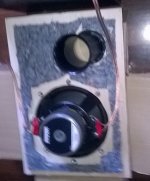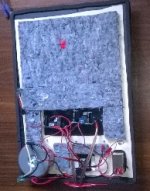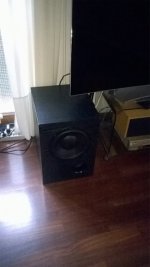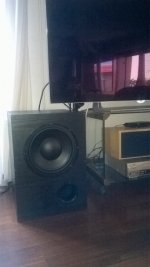Hi everyone.
Despite my very little dexterity I managed to finish my home subwoofer.
I chose a 10 inch woofer (100W+100W rms at 8 Ohm) with a double coil that I power in parallel with two identical circuit boards (30V max voltage), each equipped with a TDA7293 processor. The hypothesis was that two identical circuits are almost in phase but I could not verify it.
I only planned two finals without any preamp.
As a transformer I chose a dual toroidal 28V - 200W. I wanted to calculate the power of each final but I broke the oscilloscope and gave up.
I seemed to read that with 30V on TDA7293 I would have about 50W at 8 Ohm (47W at 28V). (Can anyone tell me if it is correct?).
As box, to save space in the living room, I chose a 1 cm poplar plywood (external dimensions in cm 35x50x40) internally upholstered on each free zone with 2cm "cascame" (in Italian) as damping material (I feared to the end for this choice).
I calculated with much approximation the equivalent diameter of the reflex tube with large flares at the ends. In conclusion with Winisd: D = 7.1cm and L = 17.65cm for a frequency of about 29Hz on a box volume of 57l (fixed Ql = 7).
The signal to the sub comes from the output of an AV receiver and, having renounced the additional preamp, I had to raise a lot the SUB calibration (I have a little rustling but it seems acceptable). I have some doubts, however, about the future comfort of this choice, since to adjusts the relative volume I have to go, every time, into the home theater settings.
I really like the sound not only in cinema effects but also in hi-fi context. However I don't know how the same woofer would play in a professional project.
Despite my very little dexterity I managed to finish my home subwoofer.
I chose a 10 inch woofer (100W+100W rms at 8 Ohm) with a double coil that I power in parallel with two identical circuit boards (30V max voltage), each equipped with a TDA7293 processor. The hypothesis was that two identical circuits are almost in phase but I could not verify it.
I only planned two finals without any preamp.
As a transformer I chose a dual toroidal 28V - 200W. I wanted to calculate the power of each final but I broke the oscilloscope and gave up.
I seemed to read that with 30V on TDA7293 I would have about 50W at 8 Ohm (47W at 28V). (Can anyone tell me if it is correct?).
As box, to save space in the living room, I chose a 1 cm poplar plywood (external dimensions in cm 35x50x40) internally upholstered on each free zone with 2cm "cascame" (in Italian) as damping material (I feared to the end for this choice).
I calculated with much approximation the equivalent diameter of the reflex tube with large flares at the ends. In conclusion with Winisd: D = 7.1cm and L = 17.65cm for a frequency of about 29Hz on a box volume of 57l (fixed Ql = 7).
The signal to the sub comes from the output of an AV receiver and, having renounced the additional preamp, I had to raise a lot the SUB calibration (I have a little rustling but it seems acceptable). I have some doubts, however, about the future comfort of this choice, since to adjusts the relative volume I have to go, every time, into the home theater settings.
I really like the sound not only in cinema effects but also in hi-fi context. However I don't know how the same woofer would play in a professional project.
Hi ubergeeknz I'm only a little worried about the slightest buzz from the woofer. I don't remember it during the test and I didn't expect it.
I have some poor quality photos. I have many others completely out of focus (At that moment I thought if the sub would work or not).
I don't know how to insert them in the post (diyaudio asks me for an url I don't have).
Do you know how to do it?
I have some poor quality photos. I have many others completely out of focus (At that moment I thought if the sub would work or not).
I don't know how to insert them in the post (diyaudio asks me for an url I don't have).
Do you know how to do it?
Hi I hope I have sent.
1) Front panel: woofer and reflex tube
2) Rear panel:
- in the center: the two boards (class AB finals) fixed to a large external heat sink in 2 pieces glued together with thermal glue
- in the lower from the left: toroidal transformer, line in, power in
3-4) External pictures
1) Front panel: woofer and reflex tube
2) Rear panel:
- in the center: the two boards (class AB finals) fixed to a large external heat sink in 2 pieces glued together with thermal glue
- in the lower from the left: toroidal transformer, line in, power in
3-4) External pictures
Attachments
Hi Claudio,
Great little project the cabinet looks very nice from outside.
Your wiring layout could well be the issue, it looks like kind of a rats nest [emoji16]
Wiring should run directly from mains in to transformer and then run neatly to the amplifiers.
Keep it away from the input wiring especially and also the speaker wiring if possible. If they must cross paths make sure it is at right angles to limit inductive pickup.
Tidy it up and twist any AC wiring (eg from the mains to transformer and from transformer to the amplifier boards).
Hope my description makes sense. Try it and see what it does for your hum.
Great little project the cabinet looks very nice from outside.
Your wiring layout could well be the issue, it looks like kind of a rats nest [emoji16]
Wiring should run directly from mains in to transformer and then run neatly to the amplifiers.
Keep it away from the input wiring especially and also the speaker wiring if possible. If they must cross paths make sure it is at right angles to limit inductive pickup.
Tidy it up and twist any AC wiring (eg from the mains to transformer and from transformer to the amplifier boards).
Hope my description makes sense. Try it and see what it does for your hum.
hello ubergeeknz,
I made some mistakes due to inexperience. Line-in put right would have solved by itself the intrigue of the wires that you noticed but the biggest mistake regards the positioning of the two boards that does not allow me to fix with ease the cables to the point that I do not trust to modify anything (I hadn't noticed it during the project). As long as everything works I don't feel like changing anything. If it should have problems, I think I will completely redo the back panel respecting your scheme.
I made some mistakes due to inexperience. Line-in put right would have solved by itself the intrigue of the wires that you noticed but the biggest mistake regards the positioning of the two boards that does not allow me to fix with ease the cables to the point that I do not trust to modify anything (I hadn't noticed it during the project). As long as everything works I don't feel like changing anything. If it should have problems, I think I will completely redo the back panel respecting your scheme.
Report after one month of use.
Hi ubergeeknz, hi everyone,
I write this post because I hope it can be useful to someone.
I'm happy with how the sub is playing (I live in a condominium and the volume must be low) but I realized I had too much vibration if I turn up the volume at 30 Hz ("Jurassic World" has this kind of bass). My woofer weighs over 6 kg and the box (1 cm plywood) is very light. I think this is the cause. I will have to fix better all the parts not glued and I will try to increase where possible the thickness of the sound-absorbing material to dissipate as much energy as possible (let me know if you think it can be an idea).
Hi ubergeeknz, hi everyone,
I write this post because I hope it can be useful to someone.
I'm happy with how the sub is playing (I live in a condominium and the volume must be low) but I realized I had too much vibration if I turn up the volume at 30 Hz ("Jurassic World" has this kind of bass). My woofer weighs over 6 kg and the box (1 cm plywood) is very light. I think this is the cause. I will have to fix better all the parts not glued and I will try to increase where possible the thickness of the sound-absorbing material to dissipate as much energy as possible (let me know if you think it can be an idea).
Greets!
Short of doing constrained layer damping, best overall is to add another complete layer of plywood over the entire box, overlapping the existing joints to clamp/seal them, preferably at least 1.8 cm thick of no-void BB, marine or appleply.
You may still need spikes to isolate it from the floor.
GM
Short of doing constrained layer damping, best overall is to add another complete layer of plywood over the entire box, overlapping the existing joints to clamp/seal them, preferably at least 1.8 cm thick of no-void BB, marine or appleply.
You may still need spikes to isolate it from the floor.
GM
Hi GM,
I am at the limit with the space of my living room (I have already reached the maximum size with 1 cm of thickness) and I must necessarily act inside. Under the diver I put felt pads to reduce the disturbance to the neighbors of the lower floor. I will replace them with spikes.
I am at the limit with the space of my living room (I have already reached the maximum size with 1 cm of thickness) and I must necessarily act inside. Under the diver I put felt pads to reduce the disturbance to the neighbors of the lower floor. I will replace them with spikes.
Hi GM,
I am at the limit with the space of my living room (I have already reached the maximum size with 1 cm of thickness) and I must necessarily act inside. Under the diver I put felt pads to reduce the disturbance to the neighbors of the lower floor. I will replace them with spikes.
Greets!
Bummer.
Right, time to brace!
Spikes [pointed end down] will help, though for future reference the speaker should be mass loaded whether in construction or stacked on top, typically 2x or more depending on how rigid it is as you can see when a vintage Altec horn system was done: High Efficiency Speaker Asylum
The cast alum horn was particularly resonant: High Efficiency Speaker Asylum
GM
Good idea. I don't need to reset the oscillations but just reduce them at least one bit. And what about the material of the braces? Can I choose wood (or aluminum) without using hard metal? Wood and aluminum can easily be cut.
Normally in a speaker and especially a sub, is to raise its resonance enough that the driver/woofer can't excite it enough to matter, i.e. no such thing as too rigid, just a point of diminishing returns.
As phivates points out, most anything that's rigid is fine for bracing, with the goal of tying all six sides together so the cab can't 'breathe'. Also, a good plan to couple [mass load] the driver to this bracing or at least a separate one specifically for it to act as an additional baffle brace and provide the driver with the most stable 'work platform' to maximize its electro-mechanical-acoustical efficiency.
GM
- Status
- This old topic is closed. If you want to reopen this topic, contact a moderator using the "Report Post" button.
- Home
- Loudspeakers
- Subwoofers
- Do you find errors in my project?



